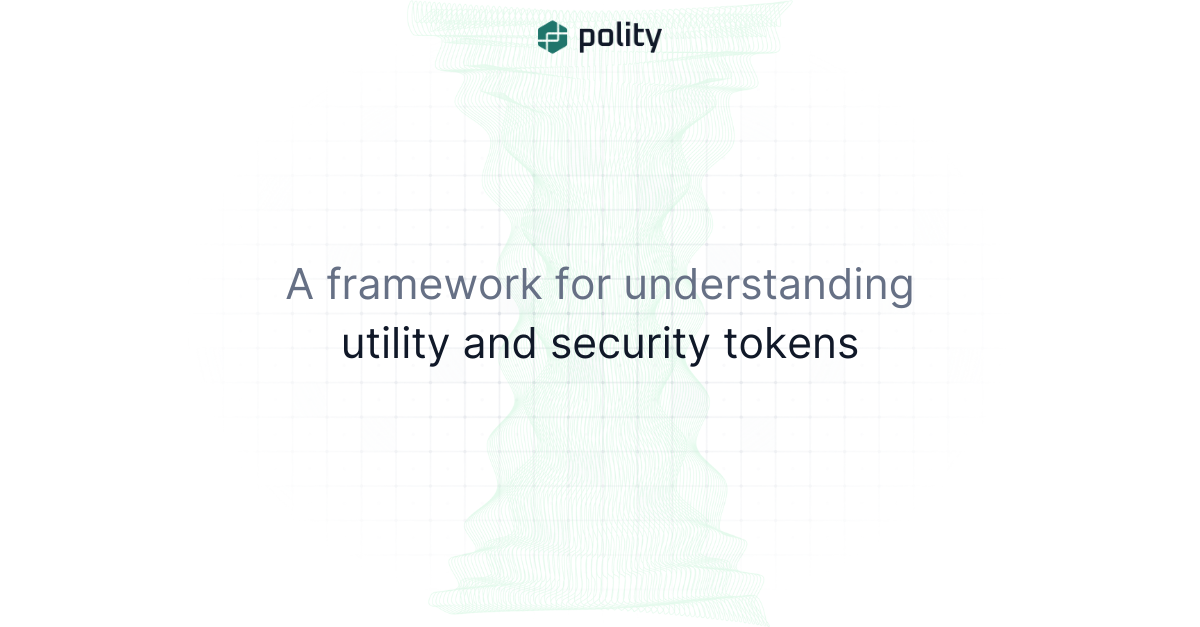While cryptocurrencies dominate much of the discourse around blockchain technology, they are only one aspect of the emerging network economy.
As the industry matures, the conversation is shifting away from mediums of exchange or stores of value to tokens and tokenisation.
Tokens, distinct from coins such as Bitcoin and Litecoin, have a broader range of potential applications.
This article will explore two token types, security tokens and utility tokens, and their nature and role in the blockchain ecosystem.
What are tokens?
Digital assets come in two main types: cryptocurrencies and crypto tokens.
Cryptocurrencies are blockchain network native assets, whereas tokens are units of value developed on top of existing blockchain networks.
How are tokens classified?
The function, capabilities, and rights that a given token carries vary, and how a token is classified also varies depending upon its characteristics in five dimensions:
1. Purpose: Tokens can serve as cryptocurrencies, aid network growth, or be investment avenues. Mislabeling can occur if the purpose is misunderstood.
2. Utility: Tokens can be categorised into:
- Usage: Provides network access/features.
- Work: Contributes to the host system.
- Hybrid: Combines both usage and work.
- Useless: Lacks utility.
3. Legal Status: With increasing regulation, a token's classification might change. Tokens without network features or not being pure cryptocurrencies might be seen as security tokens.
4. Underlying Value: Tokens have inherent monetary values, which can be IOUs for assets or resemble stocks. The network's value can influence the token's value, but determining this value is challenging.
5. Technical Layer: Tokens can be:
- Blockchain-native: The chain's own token.
- Non-native protocol: Part of a protocol on the blockchain.
- DApp tokens: Application-level tokens.
What are utility tokens?
Utility tokens are specialised digital assets that fulfil specific functions within a given blockchain network or decentralised application.
This function may be access to particular services or features or unlocking certain functionalities within a platform.
Projects commonly issue utility tokens through Initial Coin Offerings (ICOs) or Initial Dex Offerings (IDOs) to kickstart network effects and bootstrap value creation within blockchain ecosystems.
A key point to remember is utility tokens do not typically carry voting rights, differing from governance tokens.
What are some examples of utility tokens?
Many prominent projects and protocols rely on utility tokens to function. The utility of a given token varies depending on the nature of the project or protocol.
Notable examples of utility tokens include Ether (ETH), Basic Attention Token (BAT), and Chainlink (LINK).
ETH powers the Ethereum network and is used as “gas” to process transactions and pay transaction fees. As ETH is also the native token of the Ethereum blockchain, it is also a cryptocurrency.
BAT powers aspects of the Brave browser, a privacy-focused web browser that rewards users with BAT tokens for viewing opt-in advertisements. Using BAT, Brave users can also tip creators or purchase premium content and services.
Chainlink is a decentralised oracle network connecting Ethereum-deployed smart contracts to external data sources, APIs, and payment systems. LINK, the utility token of the Chainlink oracle network, rewards network operators and incentivises efficient data retrieval and network uptime.
How are utility tokens valued?
The number of users or the activity level within a given network does not determine the token value.
Instead, the token's value is determined by its actual demand and utility. Demand will increase if access to a given project or protocol is deemed valuable.
As token availability is generally capped, token value tends to increase proportionately to demand.
What are security tokens?
Security tokens are digital assets that derive value from an external, traditional financial instrument such as stocks, bonds, mutual funds, or other freely tradeable assets.
Security tokens are blockchain-native assets initially issued on-chain through a Security Token Offering (STO).
This differs from tokenised securities typically issued off-chain and then tokenised.
How are utility tokens different from security tokens?
While utility tokens provide access to services or features, security tokens represent an ownership stake in an entity, with value tied to the financial performance of the issuing entity.
Security tokens, also known as "equity tokens," offer investors a share in the company issuing the token, with the expectation of turning a profit from the investment.
This means security tokens are subject to securities regulations, offering potential improvements to securities markets such as increased transparency, greater efficiency, and improved market access.
In contrast, utility tokens do not represent an ownership stake but instead offer access to specific services or features within a blockchain project.
Utility tokens are not primarily an investment opportunity, but their value can increase if the demand for the associated project or service grows.
Discover the future of tokens with Polity Network.
Security and utility tokens sit at the convergence of traditional finance and blockchain technology.
Tokenisation is rapidly transforming the global financial landscape, enabling new financial instruments and empowering a wider range of market participants than ever before.
At Polity Network, we know that tokens will play a central role in the emerging network economy.
Hybrid tokens combining governance, utility, and security-like aspects will become the gold standard of digital assets.
Visit our website to learn more about why we think that is the case, or subscribe to this publication.
References
1. Deloitte. "Classification of Cryptocurrency Holdings." Deloitte. Accessed July 25, 2023. https://www2.deloitte.com/content/dam/Deloitte/us/Documents/audit/ASC/FRA/2018/us-aers-fra-classification-of-cryptocurrency-holdings.pdf.
2. Deltec Bank & Trust. 2022. “The Token Classification Framework.” Deltec Bank & Trust. Accessed July 27, 2023. https://www.deltecbank.com/2022/05/11/the-token-classification-framework/.
3. SoFi. "What Is a Utility Token? A Comprehensive Overview." SoFi Learn. Accessed July 22, 2023. https://www.sofi.com/learn/content/what-is-a-utility-token/.
4. 101 Blockchains. "Governance Token vs Utility Token - Key Differences." 101 Blockchains. Accessed July 24, 2023. https://101blockchains.com/governance-token-vs-utility-token/
5. "What is the difference between Utility Tokens and Security Tokens." Bitpanda Academy. Accessed July 24, 2023. https://www.bitpanda.com/academy/en/lessons/what-is-the-difference-between-utility-tokens-and-security-tokens/.
6. Ledger. "Utility Token." Ledger Academy. Accessed July 22, 2023. https://www.ledger.com/academy/glossary/utility-token.
7. INX. "What is a Security Token? Understanding the Basics of Tokenized Securities." INX. Accessed July 25, 2023. https://www.inx.co/learn/experts/what-is-a-security-token-understanding-the-basics-of-tokenized-securities/.
8. Cointelegraph. "Utility tokens vs. equity tokens: Key differences explained." Cointelegraph. Accessed July 22, 2023.
9. Linklaters. "Tokenised securities: a new roadmap for market participants and regulators in Asia." Accessed July 24, 2023. https://www.linklaters.com/en/insights/blogs/fintechlinks/2019/november/tokenised-securities-a-new-roadmap-for-market-participants-and-regulators-in-asia.
10. ASIFMA. "Tokenised Securities: A Roadmap for Market Participants and Regulators." Accessed July 24, 2023. https://www.asifma.org/wp-content/uploads/2019/11/tokenised-securities-a-roadmap-for-market-participants-final.pdf.





